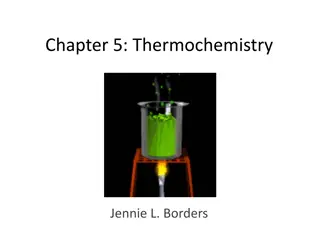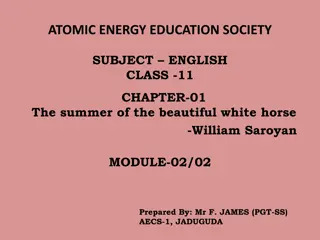
Understanding Numerical Differentiation and Integration Techniques
Explore the concepts of numerical differentiation and integration, including forward and backward difference formulas, interpolating polynomials, and error considerations. Learn how to compute derivatives and integrate functions using numerical methods. Dive into the intricacies of solving for derivatives at different points and explore the implications of higher differences in the equations on accuracy.
Download Presentation

Please find below an Image/Link to download the presentation.
The content on the website is provided AS IS for your information and personal use only. It may not be sold, licensed, or shared on other websites without obtaining consent from the author. If you encounter any issues during the download, it is possible that the publisher has removed the file from their server.
You are allowed to download the files provided on this website for personal or commercial use, subject to the condition that they are used lawfully. All files are the property of their respective owners.
The content on the website is provided AS IS for your information and personal use only. It may not be sold, licensed, or shared on other websites without obtaining consent from the author.
E N D
Presentation Transcript
1 CHAPTER 6 Numerical Differentiation and Integration June 4, 2025 By: Habtamu Garoma
Numerical Differentiation 2 Suppose ; are given. We want to find the derivative of = ( , ) iy x 2 , 1 , 0 ,..., i n i passing through the (n+1) points, at a point x. y = (x ) f If x is near to the starting value 0x , then we use Newton s forward difference interpolation formula. ( ) ( )( ) 1 1 2 u u u u u ( ) y ( ) ( ) 1 = + = + + + + 2 3 ... x y x uh y u y y y 0 0 0 0 0 2 ! 3 x x where is a polynomial of degree n in x and = 0 (x ) u y h June 4, 2025 By: Habtamu Garoma
Contd 3 Now differentiate with respect to x (x ) y 1 1 dy dy du dy du since = = = dx du dx h du dx h + + 2 3 2 1 h 2 1 3 6 2 4 18 22 6 u u u u u u ( ) 2 + + + + = 2 3 4 ... ... y y y y 0 0 0 0 2 6 24 dy at any x which may be any where in the This gives the value of dx interval. = = , 0 x x u If then (2) reduces to 0 1 h 1 1 1 dy dy = = + + 2 3 4 ... y y y y 0 0 0 0 2 3 4 dx dx = = 0 x x u 0 June 4, 2025 By: Habtamu Garoma
Contd 4 Differentiating (2) again with respect to x, and we get 2 1 d y 2 d dy du d dy = = dx du dx dx du dx h + 2 1 h 6 18 11 u u ( ) = + + + 2 3 4 1 ... y u y y 0 0 0 2 12 3 1 h 12 18 d y u = + + 3 4 ... y y 0 0 3 3 12 dx = 0 u Setting , i.e. x = 0 x 2 1 h 11 d y = + + and 2 3 4 ... y y y 0 0 0 2 2 12 dx 3 1 h 3 d y = + 3 4 ... y y 0 0 3 3 2 dx June 4, 2025 By: Habtamu Garoma
Contd 5 If x is near to the end value nx , then we use Newton s backward difference formula to compute the derivative. ( ) ( )( ) + 2 + + 1 1 2 v v v v v ( ) x ( ) ( ) = = + + + + 2 3 ... ... y y x vh y v yn y y n n n n ! 3 v x where = n v h Differentiating (*) with respect to x 1 dy dy dv dy = = dx dv dx h dv June 4, 2025 By: Habtamu Garoma
Contd 6 + + + + 2 3 2 1 h 2 1 3 6 2 4 18 22 6 dy v v v v v v = + + + + 2 3 4 ... y y y y n n n n 2 6 24 dx + 2 2 1 h 6 18 11 d y v v ( ) = + + + + 2 3 4 1 ... y v y y n n n 2 2 24 dx + 3 d y 1 h 12 18 v = + + 3 4 ... y y n n 3 3 12 dx Setting x = nx 1 h 1 1 1 dy = + + + + 2 3 4 ... y y y y n n n n 2 3 4 dx = x x n 2 1 h 11 d y = + + + 2 3 4 ... y y y n n n 2 2 12 dx = x x n 3 1 h 3 d y = + + 3 4 ... y y n n 3 3 2 dx = x x n June 4, 2025 By: Habtamu Garoma
Contd 7 If higher differences in the equation are very small, we can take only the first few terms in the interpolating polynomial and solve it for . The interpolating polynomial we find is an approximate function to the original function i.e. is small. But may not be small even if is small. This means the error involved in obtaining through may be great. So, it can be used with confidence only if the differences of some order are constants. By: Habtamu Garoma June 4, 2025
Maxima and Minima 8 We want to find the value of x at which the curve is maximum or minimum given the tabular values. Using any one of the methods developed so far, we can get the interpolating polynomial of degree n, and then using the concepts how to find maximum and minimum in calculus find the derivative of this polynomial and equate it to zero. + 2 1 h 2 1 3 6 2 dy u u u = + + + 2 3 ... y y y 0 0 0 2 6 dx + 2 2 1 3 6 2 dy u u u = + + + = 2 3 0 ... 0 y y y 0 0 0 2 6 dx June 4, 2025 By: Habtamu Garoma
Example 1 9 . The population of a certain town is given below. Find the rate of growth of the population in 1931, 1941, 1961 and 1971. Year x: 1931 1941 1951 1961 1971 Population in: 40.62 60.80 79.95 103.56 132.65 Thousands June 4, 2025 By: Habtamu Garoma
Solution 10 x p 2 3 4 p p p p 1931 40.62 20.18 -1.03 1941 60.80 5.49 19.15 -4.47 4.46 1951 79.95 1.02 23.61 5.48 1961 103.56 29.09 1971 132.65 To get the rate of growth of the population we find when (x ) p = 1931 x 1931 1931 = = = 1931 0 x u 0 10 June 4, 2025 By: Habtamu Garoma
Contd 11 1 h 1 1 1 dp dp = = + + 2 3 4 ( ) ... p p p p 0 0 0 0 2 3 4 dx dx = = 1931 0 x u 1 1 1 1 ( ) ( . 5 ) ( ) = + 20 18 . . 1 03 49 . 4 47 10 2 3 4 = 3642 . 2 5 = When 1941 x 1941 1931 = = 1 u 10 June 4, 2025 By: Habtamu Garoma
Contd 12 Putting u = 1, in + + 2 3 2 1 h 2 1 3 6 2 4 18 22 6 dp u u u u u u = + + + + and 2 3 4 ... p p p p 0 0 0 0 2 6 24 dx 1 1 1 1 dp ( ) ( . 5 ) ( . 4 ) We get, = + + 20 18 . . 1 03 49 47 10 2 6 12 dx = 1 u = 1.83775 = When , we use the backward interpolating polynomial 1961 x 1961 1971 So = = 1 v 10 June 4, 2025 By: Habtamu Garoma
Contd 13 + + + 2 1 h 2 1 3 6 2 dp v v v = + + + 2 3 ... p p p n n n 2 6 dx = 1 v = 1 v 1 1 1 1 ( . 5 ) ( . 1 ) ( ) = 2.65525 = 29 09 . 48 02 . 4 47 10 2 6 12 1971 1971 = When so = = 1971 x 0 v 10 1 1 1 1 dp = + + + + 2 3 4 ... p p p p n n n n 2 2 3 4 dx = 0 u 1 1 1 1 ( . 5 ) ( . 1 ) ( ) = 3.10525 = 29 09 . 48 02 . 4 47 10 2 3 4 June 4, 2025 By: Habtamu Garoma
Example 2 14 The table below gives the results of an observation; is the observed temperature in degrees centigrade of a vessel of cooling water and t is the time in minutes from the beginning of the observation. t: 1 3 5 7 9 : 85.3 74.5 67.0 60.5 54.3 Find the approximate rate of cooling at t = 3 and t = 3.5. June 4, 2025 By: Habtamu Garoma
Solution 15 x 2 4 3 p p p 1 85.3 10.8 3.3 3 74.4 -2.3 -7.5 1.0 1.6 5 67.0 -0.7 -6.5 0.3 7 60.5 -6.2 9 54.3 d represents the rate of cooling, we have Since dt 1 t t t = = 0 u 2 2 June 4, 2025 By: Habtamu Garoma
Contd 16 = = = = , 3 1 t u At and at , 5 . 3 . 1 25 t u = Using in (2), we get 1 u dt + + 2 3 2 1 2 1 3 6 2 4 18 22 6 d u u u u u u = + + 3 + + 2 4 ... 0 0 0 0 2 2 6 24 d 1 1 1 1 ( ) = + + + 10 8 . ) 3 . 3 ( 2 3 . 2 ) 6 . 1 ( 12 2 6 dt = 1 u 1 = = . 1 + 383333333 . 0 + 1333333333 . 0 + - 4.31666666 7 10 8 . 65 2 d ) 3 . 3 ( 1 . 1 ( 2 25 ) 1 ( 8125 . 0 1875 . 1 ( ) ii) = + + + 10 8 . 3 . 2 ) 6 . 1 ( 2 2 6 24 dt = . 1 25 u = 3.9671875 - June 4, 2025 By: Habtamu Garoma
Example 3 17 ) 6 ( y Given the following data, find and the maximum value of y. x: 0 2 3 4 7 9 y: 4 26 58 112 466 922 June 4, 2025 By: Habtamu Garoma
Solution 18 Since thex s are not equally spaced, we will use Newton s divided difference formula. Now we form the difference table ( ) x ( ) x ( ) x ( ) x f x y 2 3 4 f f f 4 0 11 2 26 7 1 32 0 11 3 58 54 1 112 4 16 0 118 1 7 466 22 228 9 922 June 4, 2025 By: Habtamu Garoma
Contd 19 By Newton s divided difference formula ( ) x ( ) ( 0 x ) ( f ) ( + )( ) ( f ) ... + = = + , , , y f f x x x x x x x x x x x 0 0 1 0 1 0 1 2 + + + 4 ( 0 )( 11 ) ( 0 )( ) 7 )( 2 ( 0 )( 2 )( ) 1 )( 3 x x x x x x = + + + 3 2 2 3 4 x x x = = + + 2 ( ' y ) 3 4 3 x x x ( ) y ( ) 6 3 ( ) 6 4 2 = + + = ' 6 3 135 x To find the maximum value of y , consider . = ( ) 0 y + + = 2 3 4 3 0 x x There is no value of x that satisfies this equation since the roots are imaginary. Thus, there is no an extremum value in the range. June 4, 2025 By: Habtamu Garoma
Numerical Integration 20 ( )dx x b a Consider . f This integral represents the area between , the x axis and the y = (x ) f x = and x = . This integration is possible as far as lines is explicitly a b (x ) f given and the function is integrable. Now suppose set of (n+ 1) paired values are given. First as we did in the case of numerical differentiation, we find by an interpolating (x ) f ( )dx x b polynomial and obtain which can approximate the value for p (x ) Pn n a ( )dx x b . p n a June 4, 2025 By: Habtamu Garoma
Contd 21 A general quadrature formula for equidistant spacing (Newton-Cote s formula) For equally spaced intervals, we have Newton s forward difference formula as ( ) ( )( ) 1 1 2 u u u u u ( ) x ( ) 1 = + + + + 2 3 ... y y u y y y 0 0 0 0 ! 2 ! 3 x x where is the interval of differencing. = 0 , u h h June 4, 2025 By: Habtamu Garoma
Contd 22 Now, instead of , we will replace it by this interpolating polynomial (x ) f of Newton. (x ) y x x x x = + = = = 0 0 xn x nh and u u n Since 0 h h + ( ) x ( )dx x x x nh Thus = 0 n f dx f x x 0 0 + ( )dx x x nh where is interpolating polynomial of degree n. = 0 (x ) Pn P n x 0 ( ) ( )( ) 1 1 2 u u ! 2 u u u n = + + + + 2 3 hdu ... y u y y y 0 0 0 0 ! 3 0 ( ) + 3 2 1 3 2 u u ! 2 u u ! 3 u n 0 du = + + + + 2 3 ... h y u y y y 0 0 0 0 June 4, 2025 By: Habtamu Garoma
Contd 23 n 3 2 4 u 3 u 2 u 4 + 3 2 u u 2 u 2 = + + + + 2 3 ... h uy y y y 0 0 0 0 ! 2 ! 3 0 2 3 2 4 1 1 n n n n = + + + + + 2 3 2 3 ) 2 ( ... h ny y y n n y 0 0 0 0 2 2 3 2 6 4 This equation is called Newton-cote s quadrature formula and is a general quadrature formula. June 4, 2025 By: Habtamu Garoma
Contd 24 By taking different values for n we get a number of special formulas. Trapezoidal Rule Put n = 1, in the quadrature formula . 1 1 + + ( ) x ( ) x x nh x h = + 0 0 f dx f dx h y y 0 0 2 x x 0 0 Since other differences do not exist if n = 1. 1 ( ) + h y y y 0 1 0 2 h ( ) + y y 0 1 2 June 4, 2025 By: Habtamu Garoma
Contd 25 + ( ) x ( )dx x n x x nh = 0 f dx f x x 0 0 + + + ( ) x ( ) x ( ) x 2 x nh x h x nh = + + + 0 0 0 ... f dx f dx f dx ( ) + + 1 x x h x n h 0 0 0 h 2 h 2 h 2 ( ) ( ) ( ) = + + + + + + ... y y y y y y =1 0 1 1 2 n n h ( ) ( ) = + + + + + 2 ... y y y y y 0 1 2 1 n n 2 This is known as a trapezoidal rule. Even though this method is very simple for calculation, the error in this case is significant June 4, 2025 By: Habtamu Garoma
Truncation error in Trapezoidal Rule 26 In the neighborhood of , we can expand by Taylor series in x y = 0 x (x ) f powers of . That is, x 0 x ( ) 2 x x ( ) y ( ) ( ) 1 = + + + ' ' ' 0 0 ... x y x x y y 0 0 0 ! 2 ( ) 2 ! 2 x x ( ) x x = + + + 1 1 ' ' ' 0 0 ... ydx y x x y y dx 0 0 0 x x 0 0 ( ) ( ) x 2 3 1 x x x x = + + + ' ' ' 0 0 0 ... y x y y 0 0 ! 2 ! 3 x 0 ( ) ( ) 2 3 x x x x ( ) = + + + ' ' ' 0 1 0 1 0 ... y x x y y 0 1 0 0 ! 2 ! 3 2 3 h h = + + + ' ' ' 0 ... hy y y (2) 0 0 ! 2 ! 3 June 4, 2025 By: Habtamu Garoma
Contd 27 If h is the equidistant length, then also h ( ) = x = + 1 ydx y y Area of the first trapezium = A0 say 0 1 2 x 0 x = Putting in (1), we get 1x ( ) 2 x x ( ) x ( ) = = + + + ' ' ' 0 1 0 ... y y y x x y y 1 1 0 1 0 0 ! 2 2 h = + + + ' ' ' 0 ... y hy y 0 0 ! 2 2 h h h ( ) = + = + + + + ' ' ' 0 ... A y y y y hy y 0 0 1 0 0 0 2 2 ! 2 2 3 h h = + + + ' ' ' 0 ... hy y y 0 0 2 ! 2 . 2 June 4, 2025 By: Habtamu Garoma
Contd 28 Subtracting A0 from (2), we obtain 1 1 x = + 1 3 ' ' 0 ... ydx A h y 0 ! 3 ! 2 . 2 x 0 1 = + 3 ' ' 0 ... h y 2 1 + 3 ' ' 0 ... h y The error made in the first interval is ( , ) x 0x 1 2 1 = 3 ' ' h iy Similarly the error in the ith interval 1 2 June 4, 2025 By: Habtamu Garoma
Contd 29 Hence, the total cumulative error E is ( ) 1 + + + + 3 ' ' 0 ' ' 1 ' ' 2 ' ' ... E h y y y ny 1 2 3 nh ' ' 0 ' ' 1 ' ' 2 = max , , ,... E M where M y y y 12 ( ) 2 b a h b a if the interval is and = M ( b a , ) h 12 n The error in the trapezoidal rule is of order h . 2 The accuracy of the result can be improved by increasing the number of intervals and decreasing the value of h. June 4, 2025 By: Habtamu Garoma
Simpsons one-third Rule 30 Setting n = 2 in Newton-cotes quadrature formula, we have 1 8 4 ( ) x x since other terms vanish = + + 2 2 2 4 f dx h y y y 0 0 0 2 3 2 x 1 ( ) ( ) 2 = + + 2 2 1 h y y y E y 0 1 0 0 3 1 ( ) = + + + 2 2 2 2 h y y y y y y 0 1 0 2 1 0 3 1 4 1 = + + h y y y 2 1 0 3 3 3 h = + + 4 y y y 2 1 0 3 June 4, 2025 By: Habtamu Garoma
Contd 31 h h ( ) x ( ) x x x Similarly, and + = + + = + ++ 4 2 i 4 4 f dx y y y f dx y y y + 2 3 4 1 2 i i i 3 3 x x 2 i If n is an even integer, then the last integral will be h 3 ( ) x x = + + n 4 f dx y y y 2 1 n n n x 2 n Adding all these integrals, if n is even positive integer, then are odd in number; we have , , , ,..., y y y y n y 0 1 2 3 x x x x x x ( ) x ( ) x n n x x 4 2 = + + + 2 ( ) ( ) ... f x dx f x dx f dx f dx 0 0 2 n h 3 ( ) ( + ) ( ) = + + + + + + + + 4 4 ... 4 y y y y y y y y y 0 1 2 2 3 4 2 1 n n n h ( ) ( ) ( ) = + + + + + + + + + 2 ... 4 ... y y y y y y y y 0 2 4 2 1 3 1 n n n 3 June 4, 2025 By: Habtamu Garoma
Simpsons three-eighths Rule 32 Putting n = 3 in Newton-cotes formula, we get 9 1 9 1 81 x x 3 0 = + + + + 2 3 ( ) 3 27 9 f x dx h y y y y 0 0 0 0 2 2 2 6 4 9 9 3 ( ) ( ) ( ) 2 3 = + + + 3 1 1 h y y y E y E y 0 1 0 0 0 2 4 8 9 9 9 3 ( ) ( ) = + + + + + 3 2 3 3 h y y y y y y y y y y 0 1 0 2 1 0 3 2 1 0 2 2 4 8 3 h ( ) = + + + 3 3 y y y y 3 2 1 0 8 June 4, 2025 By: Habtamu Garoma
Contd 33 If n is a multiple of 3, + + + + + + 3 6 3 x x nh x x h x x h h x x nh n ( ( ) x ( ) x 0 0 0 0 0 = + + + 0 0 ( ) ( ) ... f x dx f x dx f dx f dx ) 3 h 0 3 h 8 ( ) ( + ) ( ) = + + + + + + + + + + + 3 3 3 3 ... 3 3 y y y y y y y y y y y y 0 1 2 3 3 4 5 6 3 2 1 n n n n 3 h 8 ( ) ( ) ( ) = + + + + + + + + + + + 3 ... 2 y y y y y y y y y y y 0 1 2 4 5 2 1 3 6 n n n n This is Simpson s three-eighths rule and is applicable only when n is a multiple of 3. June 4, 2025 By: Habtamu Garoma
Truncation error in Simpsons formula 34 By Taylor expansion of in the neighborhood of , we x = y = 0 x (x ) f obtain ( ) ( ) 2 3 x x x x ( ) ( ) 1 = + + + + ' ' ' 0 ' ' ' 0 0 0 ... ... y y x x y y y 0 0 0 ! 2 ! 3 ( ) ( ) ( ) 2 3 ! 1 ! 2 ! 3 x x x x x x x x x x dx = + + + + ' ' ' 0 ' ' ' 0 0 0 0 2 0 2 0 ... ydx y y y y 0 0 ( ) ( ) ( ) x 2 3 4 2 x x x x x x = + + + + ' ' ' 0 ' ' ' 0 0 0 0 .. y x y y y 0 0 21 ! ! 3 ! 4 x 0 ( ) ( ) ( ) 2 3 4 x x x x x x ( ) = + + + + ' ' ' 0 ' ' ' 0 2 0 2 0 2 0 ... y x x y y y 0 2 0 0 ! 2 ! 3 ! 4 June 4, 2025 By: Habtamu Garoma
Contd 35 2 3 4 8 16 h h = + + + + ' ' ' 0 2 ' ' ' 0 2 ... hy y y h y 0 0 ! 2 ! 3 ! 4 4 5 4 2 4 h h 4 0 = + + + + + 2 ' 3 ' ' 0 ' ' ' 0 2 2 ... hy h y h y y y 0 0 3 3 15 h ( ) x = = = + + 2 area 4 A ydx y y y Now let , by Simpson s rule 1 0 1 2 3 x 0 x = Putting in (1), to get 1x ( ) x x ( ) = + + + ' ' ' 0 1 2 ... y y x x y y 1 0 1 0 0 ! 2 2 3 h h = + + + + ' ' ' 0 ' ' ' 0 ... y hy y y 0 0 ! 2 ! 3 June 4, 2025 By: Habtamu Garoma
Contd 36 x = Putting in (1), we have 2 x 2 3 4 8 h h = + + + + ' ' ' 0 ' ' ' 0 2 ... y y hy y y 2 0 0 ! 2 ! 3 2 3 ( ) h h h = + + + + + + + + + ' ' ' 0 ' ' ' 0 ' 2 ' ' 0 4 ... 2 2 ... A y y hy y y y hy h y 1 0 0 0 0 0 3 ! 2 ! 3 4 2 5 4 0 = + + + + + 2 ' 3 ' ' 0 4 ' ' ' 0 5 2 2 ... hy h y h y h y h y 0 0 3 3 18 4 5 x 4 0 = + 2 5 ... ydx A h y 1 15 18 x 0 5 h 4 0 Omitting the remaining terms involving h and = + 6 ... y 90 higher powers of h. June 4, 2025 By: Habtamu Garoma
Contd 37 5 h This means that the error made in ( ) 4 0 is = + 0,x x ... y 2 90 5 h Similarly, the error made in ( ) 4 2 and so on. , x x is y 2 4 90 5 ( ) h Hence the total error E is ( ) 4 0 4 2 = + + , ... x x is y y 0 n 9 5 nh 90 4 0 4 2 4 2 n where M is the maximum value of + E M , ..., y y y 2 Since ( ) is the last paired value because we require odd number 2, x ny 2 n of ordinates to apply Simpson s one-third rule. If the interval is , then , using this = ( n 2 ) ( , ) a b b a h ( ) 4 b a h E M 180 Hence, the error in Simpson s one-third rule is of the order h . 4 June 4, 2025 By: Habtamu Garoma
Example 1 38 7 x 1 Evaluate by using 2 dx a)Trapezoidal rule b)Simpson s rule and verify your results by actual integration June 4, 2025 By: Habtamu Garoma
Solution 39 Here and the interval length is 7-1 = 6 so we divide this = 2 ( ) y x x 6= interval into 6 equal parts with = 1 h 6 x: 1 2 3 4 5 6 7 y : 1 4 9 16 25 36 49 a)By Trapezoidal rule h ( ) ( ) 7 = + + + + + + 2 2 x dx y y y y y y y 1 7 2 3 4 5 6 2 1 1 ( ( ) ( ) ) + + + + + + = 1 49 2 4 9 16 25 36 115 2 June 4, 2025 By: Habtamu Garoma
Contd 40 a)By Simpson s one-third rule 1 ( ( ) ( ) ) 7 = + + + + + + 2 2 ) ( 4 x dx y y y y y y y 1 7 3 5 2 4 6 3 1 1 ( ) ( ) ( ) = + + + + + + 1 49 2 9 25 4 4 16 36 3 = 114 Since n = 6, we can also use Simpson s three-eighth rule. 3 ( ( ) ( ) ) 7 So = + + + + + + 2 3 2 x dx y y y y y y y 1 7 2 3 5 6 4 8 1 3 ( ( ) ( ) ( ) 16 2 ) = + + + + + + 1 49 3 4 9 25 36 8 = 114 7 3 1 1 342 x 7 = = = = 2 3 7 114 x dx 3 3 3 3 1 1 June 4, 2025 By: Habtamu Garoma
Example 2 41 dx = 1 2 . 0 h 2. Evaluate using Trapezoidal rule with , and hence , + x 2 1 0 obtain an approximate value of . June 4, 2025 By: Habtamu Garoma
Solution 42 1 ( ) x = Let y + 2 1 x x : 0 0.2 0.4 0.6 0.8 1 y : 1 0.961538461 0.862068965 0.735294117 0.609756097 0.5 dx + h ( ) ( ) 1 = + + + + + 2 y y y y y y 0 5 1 2 3 4 2 1 2 x 0 2 . 0 ( ) ( . 0 2 ) = 5 . 0 + + 862068965 . 0 + 735294117 . 0 + 6097566097 . 0 + 1 961538461 2 = 0.78373152 8 June 4, 2025 By: Habtamu Garoma
Contd 43 But by actual integration dx 1 1 = = 1 tan x + 2 0 1 4 x 0 4 783731528 . 0 134926112 . 3 To compare this approximated value of with its actual value using calculator 3.14159265 , the error is which is . 4 0.00666654 159 6 . 0 % June 4, 2025 By: Habtamu Garoma
Example 3 44 3. From the table below, find the area bounded by the curve and = = the x-axis from to . 7 47 . 7 53 x x x: 7.47 7.48 7.49 7.50 7.51 7.52 7.53 y: 1.93 1.95 1.98 2.01 2.03 2.06 2.08 June 4, 2025 By: Habtamu Garoma
Solution 45 i) By Trapezoidal rule . 0 01 ( ) x ( . 1 ) ( . 1 ) . 7 53 . 7 = + + . 1 + + + + 93 . 2 08 2 95 98 . 2 01 . 2 03 . 2 06 f dx 2 47 = 0.12035 ii) By Simpson s one-third rule . 0 01 ( ) x ( . 1 ) ( . 1 ) ( . 1 ) . 7 53 . 7 + + + + + + + 93 . 2 08 2 98 . 2 03 4 4 95 . 2 01 . 2 06 f dx 3 47 0.12036666 7 iii) By Simpson s three-eighths rule . 0 ( 3 01 ) ( ) x ( . 1 ) ( . 1 3 ) ( . 2 2 ) . 7 53 . 7 + + . 1 + + + + 93 . 2 08 95 98 . 2 03 . 2 06 01 f dx 8 47 1203375 . 0 June 4, 2025 By: Habtamu Garoma
Example 4 46 1 4.Evaluate by Simpson s one-third rule correct to five decimal ex dx 0 places. June 4, 2025 By: Habtamu Garoma
Solution 47 a = The interval 1 b ( ) b a Since error where M = Max in the range x 4M ( ) e , E h 180 1 h4 e 180 10 Now we require 6 E 4 h e 6 10 180 1 6 4 180 10 e = 090207886 . 0 1 . 0 h = Hence we take 1 . 0 h June 4, 2025 By: Habtamu Garoma
Contd 48 ( ) ( ) 1 . 0 ( ) 1 + + + + + + + + + + 2 . 0 e 4 . 0 e 6 . 0 e 8 . 0 e 1 . 0 e 3 . 0 e 5 . 0 e 7 . 0 e 9 . 0 e ex 1 2 4 dx e 3 0 718282782 . 1 By the actual integration, 1 1 = = 718281828 . 1 = x x 1 e dx e e 0 0 1 = Correct to five decimal places which is the same as the ex . 1 71828 dx 0 exact value. June 4, 2025 By: Habtamu Garoma
Example 5 49 4.The table below gives the velocity v of a moving particle at time t second. Find the distance (S) covered by the particle in 12 = seconds and also the acceleration at seconds. 2 t t: 0 2 4 6 8 10 12 v: 4 6 16 34 60 94 136 June 4, 2025 By: Habtamu Garoma
Solution 50 ds dv We know that and v = a = dt dt To get S 2 ( ( ) ( ) ( ) ) 12 vdt = = + + + + + + 4 136 2 16 60 4 6 34 94 S 3 0 = 552 meters dv = , a a To find first form the difference table dt = 2 t June 4, 2025 By: Habtamu Garoma






















